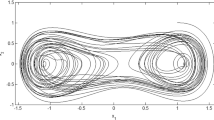Abstract
In this paper, a robust super-twisting sliding mode control with adaptive tuning law is developed for a nonlinear biotechnological process, which takes place inside a continuous stirred tank bioreactor. A super-twisting algorithm (STA) is firstly designed to obtain high robustness as well as preserve fast convergence with high accuracy. The benefit of this approach is that its design procedure is independent of the prior knowledge of the bound value of the uncertainties and perturbations. However, the STA has a drawback that provides a chattering in the control loop. In order to overcome this drawback, an adaptive tuning algorithm is developed to adjust the STA control law without frequency switching and alleviate the undesired chattering phenomenon. Then, the robustness can be achieved despite the existence of the unknown uncertainties and external perturbations for the nonlinear process. In addition, a formal proof of the global uniform asymptotic stability based on Lyapunov criterion of the closed-loop process is derived. Several simulation results show that the proposed adaptive super-twisting algorithm guarantees the performance of the STA under external disturbance and parametric uncertainty with less chattering and illustrate the overall performance improvements.












Similar content being viewed by others
References
Dochain D, Vanrolleghem PA (2001) Dynamical modelling & estimation in wastewater treatment processes. IWA Publishing, London
Wang H-H, Krstić M, Bastin G (1999) Optimizing bioreactors by extremum seeking. Int J Adapt Control Signal Process 13:651–669. https://doi.org/10.1002/(SICI)1099-1115(199912) 13:8\(<\)651::AID-ACS563\(>\)3.0.CO;2-8
Flores-Estrella RA, Alcaraz-González V, García-Sandoval JP, González-Álvarez V (2019) Robust output disturbance rejection control for anaerobic digestion processes. J Process Control 75:15–23. https://doi.org/10.1016/j.jprocont.2018.12.012
Batstone DJ, Keller J, Angelidaki I et al (2002) The IWA anaerobic digestion model no 1 (ADM1). Water Sci Technol J Int Assoc Water Pollut Res 45:65–73
Wang HP, Kalchev B, Tian Y, et al (2011) Composed adaptive control for a second-order nonlinear model of a biotechnological process. In: 2011 19th Mediterranean conference on control automation (MED), pp 1140–1143
Bastin G (2013) On-line estimation and adaptive control of bioreactors. Elsevier, Amsterdam
Mailleret L, Bernard O, Steyer J-P (2004) Nonlinear adaptive control for bioreactors with unknown kinetics. Automatica 40:1379–1385. https://doi.org/10.1016/j.automatica.2004.01.030
Nyttle VG, Chidambaram M (1993) Fuzzy logic control of a fed-batch fermentor. Bioprocess Eng 9:115–118. https://doi.org/10.1007/BF00369040
Schmitt F, Banu R, Yeom I-T, Do K-U (2018) Development of artificial neural networks to predict membrane fouling in an anoxic-aerobic membrane bioreactor treating domestic wastewater. Biochem Eng J 133:47–58. https://doi.org/10.1016/j.bej.2018.02.001
Gadkar KG, Mehra S, Gomes J (2005) On-line adaptation of neural networks for bioprocess control. Comput Chem Eng 29:1047–1057. https://doi.org/10.1016/j.compchemeng.2004.11.004
Sira-Ramírez H (1992) On the sliding mode control of nonlinear systems. Syst Control Lett 19:303–312. https://doi.org/10.1016/0167-6911(92)90069-5
Slotine J-JE, Li W (1991) Applied nonlinear control. Prentice Hall, Upper Saddle River
Young KD, Utkin VI, Ozguner U (1996) A control engineer’s guide to sliding mode control. In: Proceedings of 1996 IEEE international workshop on variable structure systems - VSS’96, pp 1–14
Utkin V, Guldner J, Shi J (2009) Sliding mode control in electro-mechanical systems. CRC Press, Boca Raton
Sira-Ramirez H, Llanes-Santiago O (1994) Dynamical discontinuous feedback strategies in the regulation of nonlinear chemical processes. IEEE Trans Control Syst Technol 2:11–21. https://doi.org/10.1109/87.273105
Fossas E, Ros RM, Fabregat J (2001) Sliding mode control in a bioreactor model. J Math Chem 30:203–218. https://doi.org/10.1023/A:1017927804488
Tham HJ, Ramachandran KB, Hussain MA (2003) Sliding mode control for a continuous bioreactor. Chem Biochem Eng Q 17:267–275
Stanchev SP (2003) A variant of an (combined) adaptive controller design introducing sliding regime in Lyapunov derivative. In: Proceedings of the 2003 American control conference, vol 1, pp 909–914
Plestan F, Shtessel Y, Brégeault V, Poznyak A (2010) New methodologies for adaptive sliding mode control. Int J Control 83:1907–1919. https://doi.org/10.1080/00207179.2010.501385
Shtessel YB, Moreno JA, Fridman LM (2017) Twisting sliding mode control with adaptation: Lyapunov design, methodology and application. Automatica 75:229–235. https://doi.org/10.1016/j.automatica.2016.09.004
Levant A (1993) Sliding order and sliding accuracy in sliding mode control. Int J Control 58:1247–1263. https://doi.org/10.1080/00207179308923053
Fridman L, Moreno J, Iriarte R (2012) Sliding modes after the first decade of the 21st century: State of the Art. Springer, Berlin
Shtessel Y, Taleb M, Plestan F (2012) A novel adaptive-gain supertwisting sliding mode controller: methodology and application. Automatica 48:759–769. https://doi.org/10.1016/j.automatica.2012.02.024
Shtessel YB, Moreno JA, Plestan F, et al (2010) Super-twisting adaptive sliding mode control: a Lyapunov design. In: 49th IEEE conference on decision and control (CDC), pp 5109–5113
Moreno JA, Osorio M (2008) A Lyapunov approach to second-order sliding mode controllers and observers. In: 2008 47th IEEE conference on decision and control. IEEE, Cancun, Mexico, pp 2856–2861
Polyakov A, Poznyak A (2009) Reaching time estimation for “Super-Twisting” second order sliding mode controller via Lyapunov function designing. IEEE Trans Autom Control 54:1951–1955. https://doi.org/10.1109/TAC.2009.2023781
Utkin VI (2013) Sliding modes in control and optimization. Springer, Berlin
Amet L, Ghanes M, Barbot J (2012) HOSM control under quantization and saturation constraints: Zig-Zag design solutions. In: 2012 IEEE 51st ieee conference on decision and control (CDC), pp 5494–5498
Emel’Yanov SV, Korovin SK, Levantovskii LV (1986) Higher-order sliding modes in binary control systems. Sov Phys Dokl 31:291
Selişteanu D, Petre E, Răsvan VB (2007) Sliding mode and adaptive sliding-mode control of a class of nonlinear bioprocesses. Int J Adapt Control Signal Process 21:795–822. https://doi.org/10.1002/acs.973
Lodhi S, Manzar MA, Raja MAZ (2019) Fractional neural network models for nonlinear Riccati systems. Neural Comput Appl 31:359–378. https://doi.org/10.1007/s00521-017-2991-y
Raja MAZ, Manzar MA, Samar R (2015) An efficient computational intelligence approach for solving fractional order Riccati equations using ANN and SQP. Appl Math Model 39:3075–3093. https://doi.org/10.1016/j.apm.2014.11.024
Raja MAZ, Samar R, Manzar MA, Shah SM (2017) Design of unsupervised fractional neural network model optimized with interior point algorithm for solving Bagley–Torvik equation. Math Comput Simul 132:139–158. https://doi.org/10.1016/j.matcom.2016.08.002
Author information
Authors and Affiliations
Corresponding author
Rights and permissions
About this article
Cite this article
Bouyahia, S., Semcheddine, S., Talbi, B. et al. An adaptive super-twisting sliding mode algorithm for robust control of a biotechnological process. Int. J. Dynam. Control 8, 581–591 (2020). https://doi.org/10.1007/s40435-019-00551-8
Received:
Revised:
Accepted:
Published:
Issue Date:
DOI: https://doi.org/10.1007/s40435-019-00551-8



